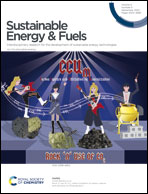Hydrogen storage characteristics of Li and Na decorated 2D boron phosphide†
Abstract
Solid-state systems serve as a candidate for clean energy applications driven by current technological demands. In this effort, density functional theory (DFT) has become a valuable asset to investigate the intrinsic electronic properties and holds a substantial promise for guiding the discovery of new materials. Herein, we have investigated the Li and Na decorated 2D boron phosphide (BP) monolayer as a potential candidate for hydrogen storage due to its lightweight and structural stability. Li and Na adatoms prefer to adsorb at the center of the hexagon with the binding energies 0.36 and 0.26 eV, respectively. The thermodynamic stabilities of BP monolayer in cases of 4Li@BP and 4Na@BP systems were evaluated at room temperature using ab initio molecular dynamics (AIMD) simulations. The study of the electronic structure revealed that the semiconducting BP sheets become metallic after the adatom adsorption. It was found that the dispersed Li and Na atoms on the monolayer surface significantly increase both the hydrogen binding energies and the hydrogen storage capacities. With one-sided coverage of Li and Na atoms, four H2 molecules were adsorbed with a gravimetric capacity of 4.917 and 4.558 wt%, respectively. For double-sided adatom coverage, a total of 16H2 molecules was captured around 4Li@BP and 4Na@BP complex with a gravimetric capacity of 7.402 and 6.446 wt%, respectively. These results suggest that boron phosphide (BP) can act as an effective substrate for H2 storage by carefully engineering it with metal decoration.



 Please wait while we load your content...
Please wait while we load your content...